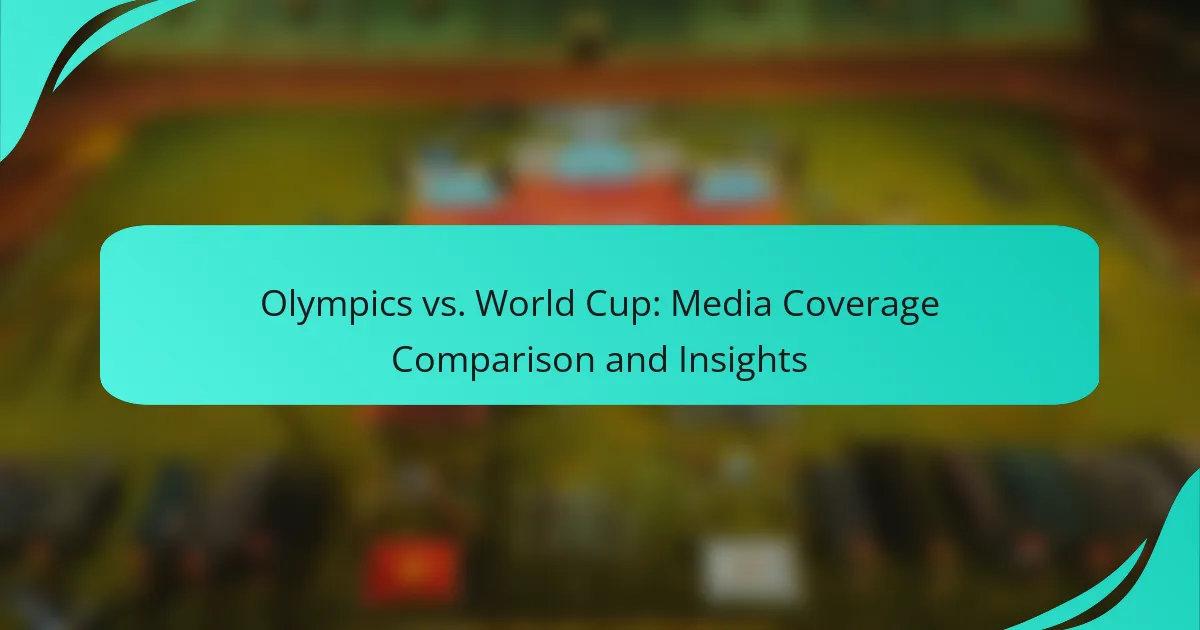The media coverage of the Olympics and the World Cup presents distinct differences in scope, focus, and audience engagement. While the Olympics feature a diverse array of sports, the World Cup’s singular focus on soccer influences the strategies employed by media outlets. Key metrics such as viewership ratings and social media engagement reveal insights into the effectiveness of these coverage approaches, shaped further by regional preferences and cultural significance.
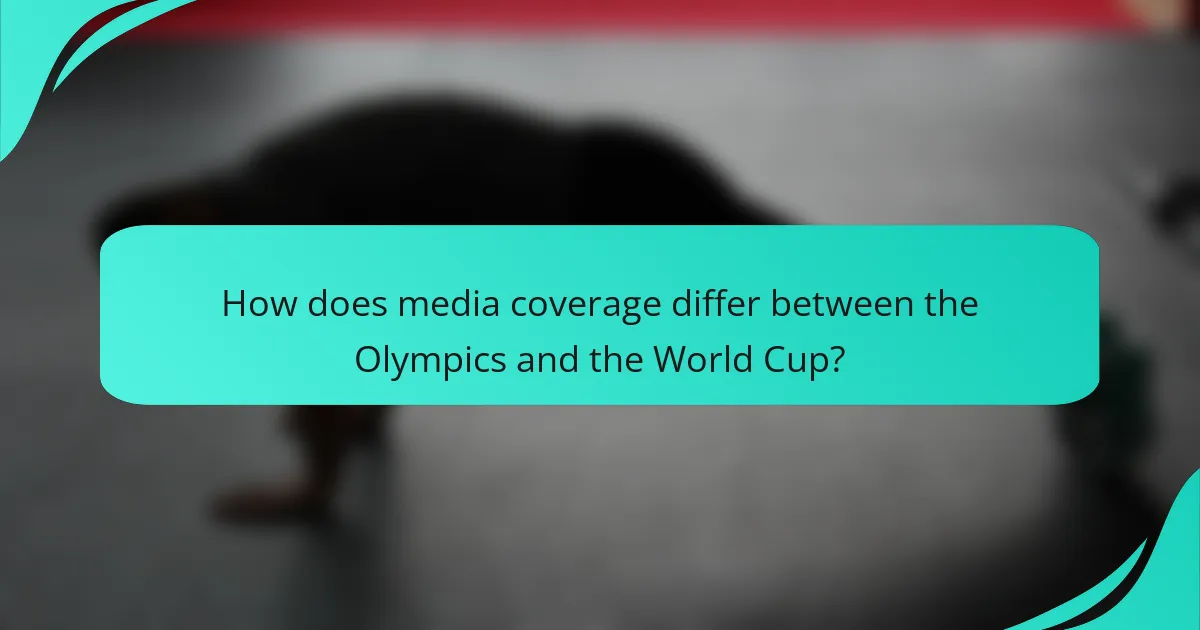
How does media coverage differ between the Olympics and the World Cup?
Media coverage for the Olympics and the World Cup varies significantly in scope, focus, and audience engagement. While the Olympics showcase a wide range of sports, the World Cup centers primarily on soccer, leading to different strategies in how each event is presented to viewers.
Olympics coverage focuses on diverse sports
The Olympics feature a multitude of sports, ranging from athletics to gymnastics and swimming. This diversity allows broadcasters to cater to various interests, showcasing lesser-known events alongside popular ones. Coverage often includes human interest stories, athlete backgrounds, and cultural elements, enhancing viewer engagement.
For instance, during the Olympics, audiences can expect extensive coverage of sports like fencing or handball, which may not receive as much attention outside the Games. This broad approach helps to attract a wider demographic, appealing to both casual viewers and dedicated sports fans.
World Cup coverage emphasizes soccer
In contrast, World Cup media coverage is heavily focused on soccer, reflecting its status as one of the world’s most popular sports. Broadcasts typically highlight key matches, player statistics, and team strategies, with a strong emphasis on national pride and rivalries. This singular focus allows for deep dives into the sport’s nuances.
For example, during the World Cup, viewers can expect detailed analyses of match tactics, player performances, and historical context, which resonate with soccer enthusiasts. The coverage is often more intense and competitive, mirroring the excitement of the tournament itself.
Audience engagement strategies vary
Engagement strategies differ markedly between the two events. The Olympics often utilize a mix of storytelling, social media interaction, and live coverage of multiple events to keep audiences engaged. This approach encourages viewers to explore different sports and share their experiences online.
On the other hand, World Cup coverage tends to focus on real-time updates, match highlights, and interactive content related to soccer. Fans are often encouraged to participate in discussions and predictions, creating a more immersive experience centered around each match.
Broadcasting rights impact coverage
Broadcasting rights play a crucial role in shaping how each event is covered. The Olympics are typically broadcasted by multiple networks across different countries, leading to a more fragmented coverage landscape. This can result in varying quality and depth of coverage depending on the broadcaster.
Conversely, the World Cup often has fewer broadcasters with exclusive rights in many regions, allowing for a more uniform presentation. This exclusivity can lead to higher production values and more comprehensive coverage, as networks invest heavily in promoting the event and enhancing viewer experience.
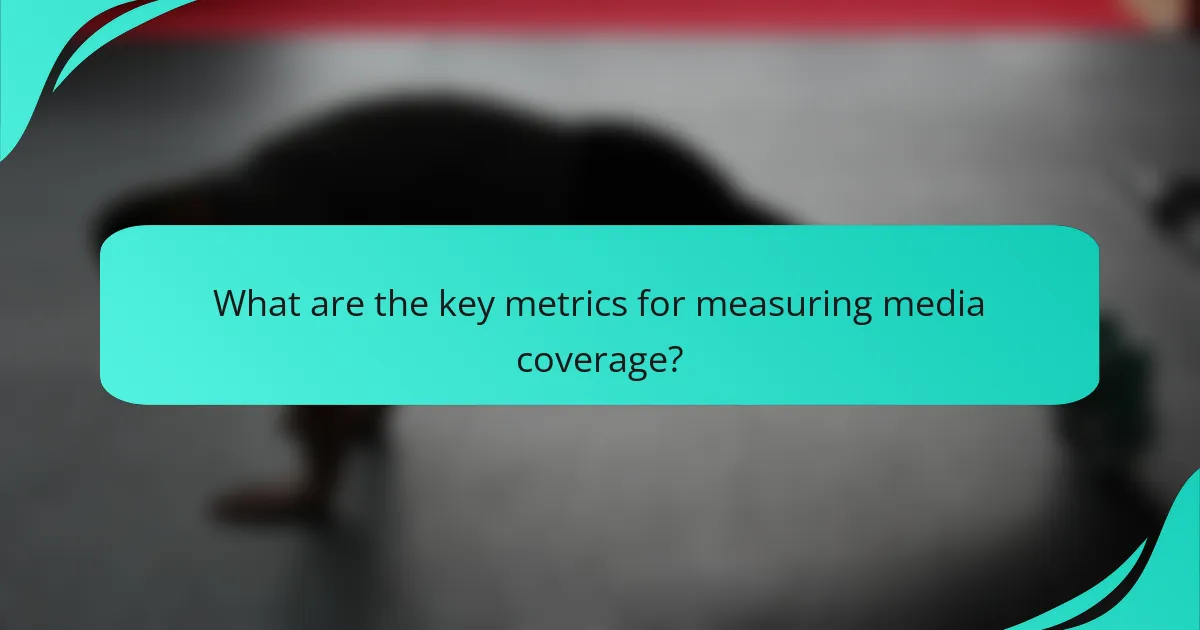
What are the key metrics for measuring media coverage?
Key metrics for measuring media coverage include viewership ratings, social media engagement, and advertising revenue. These metrics provide insights into audience reach, interaction levels, and financial impact, helping to evaluate the effectiveness of media strategies for events like the Olympics and the World Cup.
Viewership ratings for major events
Viewership ratings are crucial for understanding how many people are watching a particular event. For the Olympics and World Cup, ratings can vary significantly, often reaching hundreds of millions globally during peak moments. For instance, the final matches typically attract the highest ratings, sometimes exceeding 100 million viewers in major markets.
Comparative analysis shows that the World Cup often garners higher average ratings in many countries, particularly in Europe and South America, while the Olympics may have broader appeal across diverse sports. It’s essential to consider regional preferences when evaluating these ratings.
Social media engagement statistics
Social media engagement statistics reflect how audiences interact with content related to major events. Metrics such as likes, shares, comments, and hashtags provide insight into audience sentiment and involvement. For example, during the last World Cup, social media posts related to the event generated billions of interactions across platforms like Twitter and Instagram.
Engagement can vary by event; the Olympics may see spikes in activity during specific sports, while the World Cup generates consistent engagement throughout the tournament. Brands often leverage these statistics to shape marketing strategies and enhance viewer connection.
Advertising revenue comparisons
Advertising revenue is a key indicator of the financial impact of media coverage for major events. The World Cup typically generates higher advertising revenue due to its concentrated viewership and global appeal, with brands willing to pay premium rates for ad slots during matches.
In contrast, while the Olympics also attract significant advertising dollars, the revenue can be more dispersed across various sports and events. Advertisers often analyze past performance and audience demographics to determine the best investment strategies for these major sporting events.
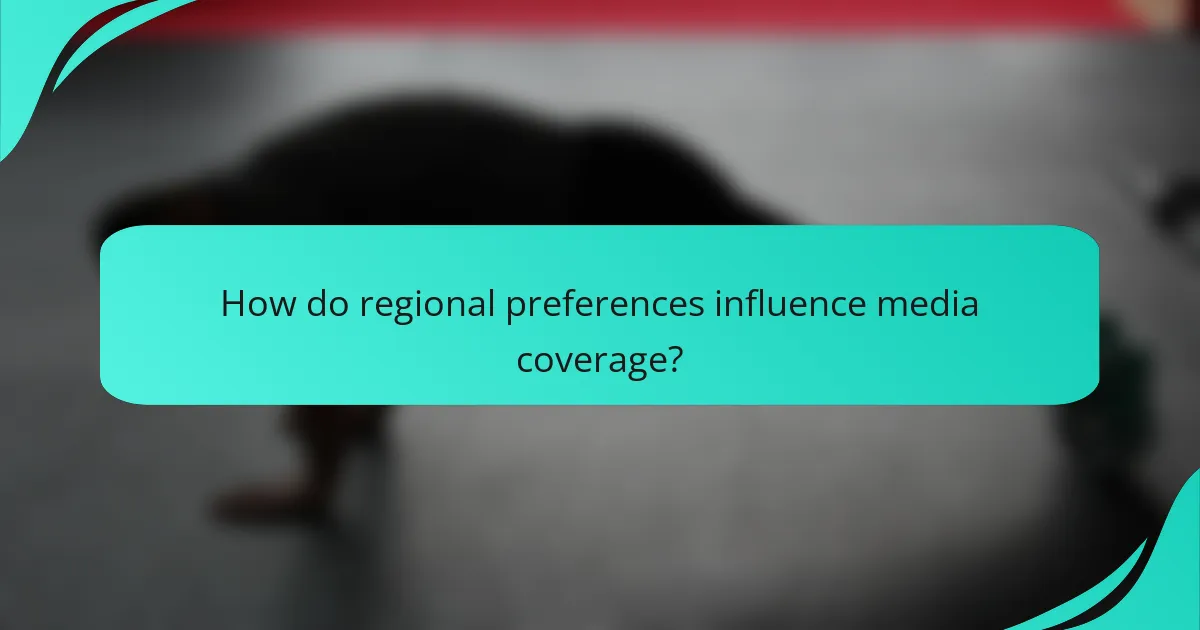
How do regional preferences influence media coverage?
Regional preferences significantly shape how media outlets cover the Olympics and the World Cup, impacting viewership and advertising strategies. Different regions prioritize these events based on cultural significance, historical context, and audience engagement.
North America favors the Olympics
In North America, the Olympics receive considerable media attention, often overshadowing other sports events. The multi-sport format and the inclusion of winter sports resonate well with American and Canadian audiences, leading to extensive coverage across television and digital platforms.
Major networks invest heavily in Olympic broadcasting, often dedicating entire channels to the event. This results in high viewership numbers, with millions tuning in for the opening ceremonies and key competitions.
Europe prioritizes the World Cup
Europeans typically place a higher emphasis on the FIFA World Cup, viewing it as the pinnacle of football (soccer) competition. Major football leagues and clubs drive this interest, creating a passionate fan base that engages deeply with the tournament.
Media coverage in Europe is extensive, with multiple broadcasters competing for rights, leading to a saturation of content across various platforms. This includes pre-tournament build-up, live match coverage, and post-match analysis, ensuring that fans are consistently engaged.
Asia’s growing interest in both events
Asia is witnessing a rising interest in both the Olympics and the World Cup, driven by increasing investment in sports infrastructure and the popularity of sports among younger demographics. Countries like Japan and South Korea have shown strong support for the Olympics, while nations such as China are increasingly engaging with football.
Media coverage in Asia is evolving, with digital platforms gaining prominence alongside traditional broadcasting. This shift allows for more interactive and accessible content, catering to a diverse audience that values both events. As a result, advertisers are keen to tap into this growing market, enhancing the overall media landscape for both the Olympics and the World Cup.
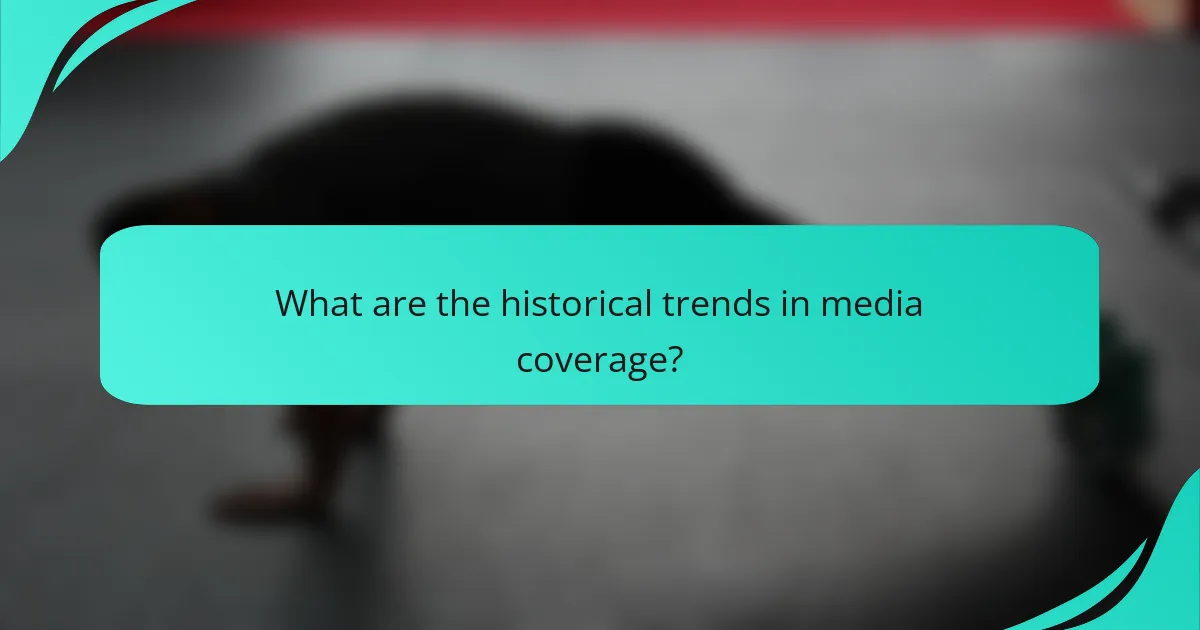
What are the historical trends in media coverage?
Media coverage of the Olympics and the World Cup has evolved significantly over the decades, influenced by technological advancements and changing audience preferences. Both events have seen shifts in how they are broadcasted, who watches them, and the platforms used for coverage.
Evolution of broadcasting technology
The evolution of broadcasting technology has played a crucial role in how the Olympics and World Cup are covered. Initially, events were broadcasted via radio and later transitioned to television, which expanded viewership dramatically. Today, high-definition broadcasts, live streaming, and virtual reality experiences enhance viewer engagement and accessibility.
For instance, the introduction of satellite technology in the 1980s allowed for global coverage, making it possible for audiences worldwide to watch events live. Recent advancements, such as 4K and 8K resolution broadcasts, provide even more immersive viewing experiences.
Changes in viewer demographics
Viewer demographics for both the Olympics and World Cup have shifted over time, reflecting broader societal changes. Younger audiences, particularly millennials and Gen Z, are increasingly consuming content online rather than through traditional television. This trend has prompted organizers to adapt their media strategies to engage these demographics effectively.
For example, social media platforms like Instagram and TikTok are now essential for reaching younger viewers, with highlights and behind-the-scenes content driving engagement. Understanding these demographic shifts is vital for sponsors and advertisers aiming to connect with target audiences.
Impact of digital media on coverage
Digital media has transformed how the Olympics and World Cup are covered, allowing for real-time updates and interactive content. Fans can now access live scores, player statistics, and personalized content through various digital platforms, enhancing their viewing experience.
Moreover, digital media enables broadcasters to reach niche audiences through targeted advertising and tailored content. This shift has led to a more fragmented media landscape, where traditional broadcasters compete with online platforms for viewer attention. Embracing digital strategies is essential for maximizing reach and engagement in today’s media environment.

How do sponsorships affect media coverage?
Sponsorships significantly influence media coverage by determining the financial resources available for broadcasting and promoting events. Major sponsors often dictate the narrative and visibility of the Olympics and the World Cup, shaping how these events are presented to audiences worldwide.
Major sponsors for the Olympics
The Olympics attract a range of high-profile sponsors, including multinational corporations like Coca-Cola, Samsung, and Visa. These companies invest heavily, often in the hundreds of millions of dollars, to secure exclusive advertising rights and visibility during the Games.
This sponsorship not only enhances the financial viability of the Olympics but also influences the media coverage, as networks prioritize content that aligns with their sponsors’ branding and marketing strategies.
Key sponsors for the World Cup
The FIFA World Cup features prominent sponsors such as Adidas, Budweiser, and McDonald’s, who also contribute substantial funding to the event. Similar to the Olympics, these sponsorships can reach into the hundreds of millions, providing necessary resources for extensive media coverage.
These sponsors play a crucial role in shaping the media narrative, often leading to tailored content that highlights their involvement and enhances viewer engagement through targeted advertising campaigns.
Comparative analysis of sponsorship impact
While both the Olympics and the World Cup benefit from significant sponsorships, the impact on media coverage can differ. The Olympics often have a broader range of sponsors due to the diversity of events, while the World Cup tends to focus on fewer, more prominent brands.
In terms of viewer engagement, the World Cup may generate more immediate excitement and higher viewership numbers, leading sponsors to invest heavily in real-time advertising strategies. Conversely, Olympic sponsors may focus on long-term brand building through storytelling and emotional connections with audiences.

What are the emerging trends in sports media coverage?
Emerging trends in sports media coverage include a shift towards digital platforms and the incorporation of advanced technologies. These changes are reshaping how audiences engage with events like the Olympics and the World Cup.
Increased focus on streaming platforms
Streaming platforms are becoming the primary medium for sports consumption, as viewers increasingly prefer on-demand access over traditional broadcasts. Major events, including the Olympics and World Cup, are now often available through multiple streaming services, allowing for flexible viewing options.
For instance, platforms like Peacock, ESPN+, and DAZN have secured rights to stream various sports events, catering to diverse audiences. This trend is expected to continue, with estimates suggesting that streaming could account for a significant portion of sports viewership in the coming years.
Integration of augmented reality experiences
Augmented reality (AR) is enhancing sports media coverage by providing immersive experiences that engage viewers in new ways. AR technology allows fans to access real-time statistics, player information, and interactive graphics during live broadcasts, enriching their viewing experience.
For example, during the Olympics, broadcasters may use AR to overlay athlete stats on the screen or create virtual replays that viewers can manipulate. This integration not only captivates audiences but also encourages deeper interaction with the content, making it a valuable trend in sports media.
